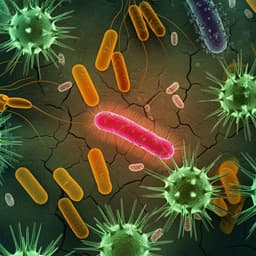
Interdisciplinary Studies
Mapping the urban and rural planning response paths to pandemics of infectious diseases
H. Zhang and J. Li
This research by Haozhe Zhang and Jinyi Li presents a comprehensive map that reveals the logical connections between urban and rural planning issues and epidemic infectious diseases. The map aids in simplifying pandemic planning by highlighting critical elements like pathogen exposure and travel.
~3 min • Beginner • English
Introduction
The paper asks what role urban and rural planning should play in dealing with infectious diseases and how planners can link epidemic prevention visions with concrete actions. The authors argue that pandemics occur frequently enough to intersect with typical 15–20-year planning cycles and thus must be incorporated into planning. While planning historically emerged from public health concerns (e.g., the 1848 UK Public Health Act), contemporary practice has shifted toward injuries and chronic/mental health, leaving a gap in infectious disease readiness. Much recent pandemic-related planning research is fragmented, emphasizing physical or technological determinism (e.g., social distancing) and producing irreconcilable debates. The authors advocate a comprehensive approach that starts from planning as a whole, integrating both physical and digital dimensions (including infodemics). Focusing on pandemic-level threats (which subsume endemic concerns), they aim to analyze the chain of infection alongside urban–rural development actions to produce a practical map for planners showing how planning decisions influence the occurrence and transmission of infectious diseases.
Literature Review
The authors screened 60 studies from SpringerLink, IEEE, ScienceDirect, Nature, and CNKI that addressed mechanisms of infectious epidemics and the impacts of globalization, urbanization, and agricultural development. Across the literature, two main consensuses emerge: (1) different landscapes (urban, suburban, farmland, forest, grassland) differentially influence emergence and spread—urbanization and agricultural expansion often increase exposure opportunities by reducing biodiversity, releasing pathogenic organic matter, and intensifying spatiotemporal human connectivity; (2) multiple drivers interact via complex positive and negative feedbacks—for example, urban agglomeration improves medical capacity yet enables rapid spread; urban expansion increases human–wildlife interfaces; agricultural intensification improves nutrition but fosters zoonoses. Empirical synthesis shows a majority of emerging infectious disease events are zoonotic (60.3%), with most zoonotic pathogens (71.8%) originating from wildlife; 60–80% of all human infectious diseases are zoonotic, at least 70% from wild fauna/flora. The literature, however, lacks a comprehensive, planning-oriented solution that manages the physical environment to prevent outbreaks, motivating the development of the atlas mapping planning issues to outbreak mechanisms.
Methodology
The study couples epidemiology’s chain of infection (reservoir, mode of transmission, host) with urban–rural planning. Method steps: (1) Theoretically analyze the chain of infection to identify two links (occurrence and transmission) and their direct causes: for occurrence—human–pathogen contact opportunities and pathogen drug resistance; for transmission—reservoirs and transmission modes, host reservoirs, travel, and trade. (2) Systematically review 60 relevant publications across major databases to extract how changes in physical and social environments affect infectious disease dynamics. (3) Synthesize findings into 12 planning issues spanning urban and rural aspects: land expansion; population concentration; climate change; social inequality; health care improvements; transportation improvements; built environment change; increased income; knowledge and education; increased food supply; increased agricultural inputs and irrigation; increased livestock farming. (4) Construct a comprehensive atlas (Fig. 2) linking each issue to intermediate effects (e.g., capacity to cure, medical attractiveness, lower biodiversity, field trips, deterioration/improvement of physical environment, individual protection ability, personal immunity) and to outbreak mechanisms (occurrence and transmission pathways). (5) Summarize and interpret the pathways to reveal conflicts/synergies among planning strategies and provide a tool for planners to evaluate policies regarding pathogen exposure, resistance, hosts, travel, and trade.
Key Findings
- The atlas clarifies how 12 planning issues influence infectious disease occurrence and transmission via distinct, often interacting pathways.
- Land expansion (urban and rural): increases human–wildlife contact and lowers biodiversity, elevating zoonotic spillover risk. Estimates suggest 60–80% of human infectious diseases are zoonotic, at least 70% from wildlife. Suburban expansion linked to Lyme disease via predator loss and mouse increase; farmland-driven forest fragmentation associated with diarrheal and acute respiratory infections.
- Population concentration (urban): mobility and high density raise contact opportunities and facilitate conversion of carriers to new infection sources; respiratory diseases (e.g., measles, viral pneumonia, COVID-19) more likely to spread in dense cities.
- Climate change (both): expands reservoirs/transmission routes by improving conditions for hosts/vectors and reducing biodiversity; El Niño events amplified rodent populations and Hantaan virus spread.
- Social inequality (urban): limits access to information, services, and care, increasing both occurrence and spread; associated with higher risks of dengue, schistosomiasis, leptospirosis; undermines herd immunity strategies.
- Healthcare improvements (urban): increased curing capacity reduces human reservoirs; increased medical attractiveness can intensify transmission (e.g., HAIs, medical tourism). Drug overuse risks new resistant variants.
- Transportation improvements (urban): elevate leisure travel into wild areas (more wildlife contact) and accelerate interregional travel/trade-driven spread; hub and port cities become outbreak centers (e.g., cholera via commerce; dengue via trade; roads altering diarrheal transmission).
- Built environment change (urban): deterioration (poor sanitation, waste/sewage management, overcrowded/poor housing, inadequate ventilation) increases animal/environmental reservoirs and human contact; improvement curbs reservoirs and inhibits emergence.
- Increased income (both): enhances education and self-protection, generally reducing incidence and spread; urban areas often show higher prevention/control capacity than rural.
- Knowledge and education (both): improve health behaviors, early care-seeking, and resilience to infodemics, thereby reducing emergence and spread.
- Increased food supply (rural): improves nutrition and immunity, lowering susceptibility, yet agricultural expansion correlates with >50% of zoonotic EIDs.
- Increased agricultural inputs and irrigation (rural): can reduce biodiversity, impair wildlife health, increase pathogen resistance, and create water-related reservoirs (e.g., malaria, lymphatic filariasis).
- Increased livestock farming (rural): raises human–livestock–wildlife contact and antimicrobial resistance risks (avian/swine influenza, MERS, H7N9), yet also improves nutrition with some protective effects.
- Cross-cutting: Occurrence is driven by contact opportunities and pathogen resistance; transmission by reservoirs/transmission modes, host reservoirs, travel, and trade. Climate change, degraded built environments, reduced diversity, and certain agricultural practices increase reservoirs and routes; improved environments and healthcare (curative capacity) reduce them. Transportation boosts trade/travel-mediated spread; social inequality amplifies vulnerabilities.
- Practical output: A comprehensive atlas (Fig. 2) and an issues–aspects table (Table 1) providing a structured framework for planning evaluation and policy design.
Discussion
The findings directly address how planning can influence pandemic dynamics by mapping planning decisions to infection occurrence and transmission mechanisms. The atlas demonstrates the need for comprehensive, cross-sectoral planning that integrates hard (infrastructure, land use, design) and soft (education, equity, healthcare access, ecology) issues. It guides planners to evaluate strategies through key lenses: pathogen exposure opportunities, pathogen resistance, hosts, travel, and trade. The discussion emphasizes: (1) bridging knowledge gaps via a holistic view that extends beyond physical space and includes digital infodemics; (2) redefining planning’s scope to integrate social determinants (education, poverty, inequality, healthcare development) critical to disease control; (3) elevating soft issues’ importance alongside hard infrastructure due to their strong indirect effects on health outcomes; (4) balancing cooperation and self-sufficiency in industrial composition (e.g., emergency supplies) and recognizing the disease-spread risks tied to tourism and trade; (5) understanding that population density is not determinative alone—education and management can mitigate risks without inducing land sprawl that may worsen zoonotic risks. Overall, the atlas helps resolve policy trade-offs by revealing conflicts/synergies across planning choices.
Conclusion
The study delivers a first comprehensive map linking urban–rural planning issues to infectious disease emergence and spread, offering planners a practical tool to evaluate and design policies around exposure, resistance, hosts, travel, and trade. It reframes planning as a comprehensive social practice that coordinates physical and nonphysical measures, moving beyond adding physical systems alone. Methodologically, it proposes a higher-order interaction approach coupling the chain of infection with 12 planning issues to reveal systemic relations. Future research should deepen the conceptual expansion of planning (e.g., integrating broader societal systems and digital environments) and explore ideal physical spatial patterns for epidemic response, complementing the atlas with empirical evaluations and implementation guidance.
Limitations
The authors note: (1) the conceptual expansion of planning beyond physical space is proposed but not demonstrated in depth; (2) the study gives limited attention to identifying or testing ideal urban physical spatial forms for epidemic response, positioning planning as comprehensive social practice rather than prescribing forms. They also acknowledge the complexity of cross-disciplinary factors and that planning is only one component of societal epidemic responses.
Related Publications
Explore these studies to deepen your understanding of the subject.







